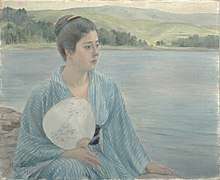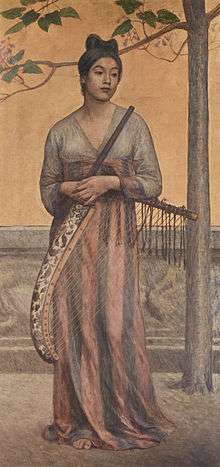Yōga
Yōga (洋画, literally "Western-style painting") is a term, coined in the Meiji period, to distinguish works from indigenous traditional Japanese paintings, or Nihonga (日本画). It designates a style of paintings by Japanese artists made in accordance with Western (European) traditional conventions, techniques and materials.


History
European painting was introduced to Japan during the late Muromachi period along with Christian missionaries. Early religious works by Japanese artists in imitation of works brought by the missionaries can be considered some of the earliest forms of Yōga. However, the policy of national seclusion introduced by the Tokugawa bakufu in the Edo period effectively ended the influence of western art on Japanese painting, with the exception of the use of perspective, which was discovered by Japanese artists in sketches found in European medical and scientific texts imported from the Dutch via Nagasaki.
In 1855, the Tokugawa bakufu established the Bansho Shirabesho, a translation and research institute for western studies, including a section to investigate western art. This section was headed by Kawakami Tōgai, whose assistant Takahashi Yuichi was a student of English artist Charles Wirgman. Takahashi is regarded by many as the first true Yōga painter.
In 1876, the Kobu Bijutsu Gakkō (Technical Art School) was established by the Meiji government as Japan's first dedicated Yōga art school. Foreign advisors, such as the Italian artist Antonio Fontanesi, were hired by the government to teach Japanese artists, such as Asai Chū in the latest western techniques.
In the 1880s, the general reaction against Westernization and the growth in popularity and strength of the Nihonga movement caused the temporary decline of Yōga. The Kobu Bijutsu Gakkō was forced to close in 1883, and when the Tokyo Bijutsu Gakkō (the forerunner of the Tokyo National University of Fine Arts and Music) was established in 1887, only Nihonga subjects were taught.
However, in 1889, the Meiji Bijutsukai (Meiji Fine Arts Society) was established by Yōga artists, and in 1893, the return of Kuroda Seiki from his studies in Europe gave fresh impetus to the Yōga genre, with the establishment of the Hakuba-kai (White Horse Society). From 1896, a Yōga department was added to the curriculum of the Tokyo Bijutsu Gakkō, and from that point onwards, Yōga has been an accepted component of Japanese painting.
Since that time, Yōga and Nihonga have been the two main divisions of modern Japanese painting. This division is reflected in education, the mounting of exhibitions, and the identification of artists. However, in many cases Nihonga artists also adopted realistic Western painting techniques, such as perspective and shading. Because of this tendency to synthesize, although Nihonga forms a distinct category within the Japanese annual Nitten exhibitions, in recent years, it has become increasingly difficult to draw a distinct separation in either techniques or materials between Nihonga and Yōga.
Materials
Yōga in its broadest sense encompasses oil painting, watercolors, pastels, ink sketches, lithography, etching and other techniques developed in western culture. However, in a more limited sense, Yōga is sometimes used specifically to refer to oil painting.
See also
- List of Yōga painters
- Akita ranga - "Dutch pictures", the Edo period predecessor to yōga
- Uki-e - "floating pictures", woodblock prints utilizing western linear perspective.
- Japonisme
References
- Keene, Donald. Dawn to the West. Columbia University Press; (1998). ISBN 0-231-11435-4
- Mason, Penelope. History of Japanese Art . Prentice Hall (2005). ISBN 0-13-117602-1
- Sadao, Tsuneko. Discovering the Arts of Japan: A Historical Overview. Kodansha International (2003). ISBN 4-7700-2939-X
- Schaarschmidt Richte. Japanese Modern Art Painting From 1910 . Edition Stemmle. ISBN 3-908161-85-1
- Weisenfeld, Gennifer. MAVO: Japanese Artists and the Avant-Garde, 1905-1931. University of California Press (2001). ISBN 0-520-22338-1
External links
![]()